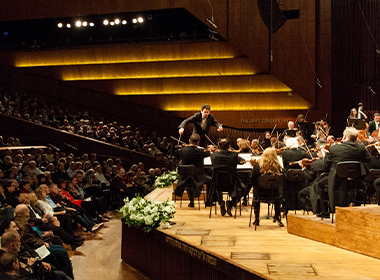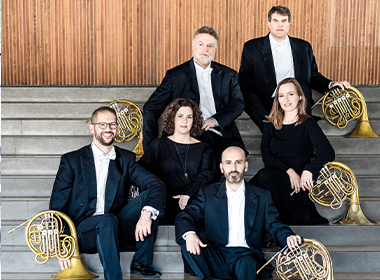The IPO is delighted to welcome back the Finnish conductor Osmo Vänskä, who received rave reviews on his previous visits here.
Due to instructions of the Health Ministry prohibiting entry into Israel of foreigners from certain countries, baritone Thomas Hampson, who was travelling from Switzerland, and percussionist Martin Grubinger, who was to travel from Austria, are unable to appear with us in the forthcoming concerts.
The concerts will take place as scheduled. The Schubert songs will be replaced with Mozart‘s Symphony no. 35 (”Haffner”), and Aho‘s Concerto for Percussion will be replaced with Mozart‘s Clarinet Concerto, with Osmo Vänskä as soloist and conductor.
Bach-Skrowaczewski: Toccata and Fugue in D minor
One of the most disturbing inventions during the period of austerity was the food substitute “Eggplants that taste like liver” or “Cimacao that tastes like chocolate” (chicory, etc.). The musical parallel to this processed food is Bach’s Toccata and Fugue in D minor “which tastes like Richard Strauss”. “Also sprach Bachatustra”? Trumpets and trombones, timpani and cascades of double-basses (dubbed a “plethora of color”) paint Bach’s sophisticated counterpoint in Technicolor. Perhaps the “blame” (or the enjoyment, depending on your perspective) for this arrangement can be put on the world of film. Leopold Stokowski, an important conductor, influential music director and a man with an instinct to break stylistic boundaries, presented the world with the famous arrangement of this Toccata in the soundtrack to Walt Disney’s film, Fantasia. What caused Stanislaw Skrowaczewski, a wonderful conductor, important composer and artist, who organized the avant-garde Zodiac Group in post-War Paris, to create this arrangement? Perhaps the invitation he received from George Szell to conduct the Cleveland Symphony in the 60’s aroused in him the need to bask in his own repertoire, and perhaps, this work expresses a stylistic concept that challenges the objective performance of Bach’s works. In any event, placing this work in a concert that also features a premiere of a percussion concerto and a late symphony by Sibelius creates an intriguing context for contemplation about sonorities in general, and specifically in this work.
Mendelssohn: Symphony no. 3
A conundrum: Mendelssohn composed five symphonies, however this symphony, the Third, was the last he wrote. Composed in 1842, the Symphony numbered four was written in 1833 and the Fifth was completed in 1830. Another strange thing: when the symphony was premiered (in 1842), the composer did not entitle it “Scottish”, and it did not receive any subtitle even after the score was published. Perhaps the lack of extra-musical reference reflects the side that the composer took in the aesthetic controversy which prevailed in the 19th century between the symphonists, who believed in “pure (objective) music”, which does not have any extra-musical characteristics (the prominent enthusiasts of this line of thought were Johannes Brahms and Robert Schumann) and the dramatic Romantics (headed by Berlioz, Liszt and Wagner), who believed that the boundaries of “pure music” can be broken by referrals to extra-musical sources. Mendelssohn, who hinted in the titles that he gave to some of his works (including “Fingal’s Cave”, “Calm Sea and Prosperous Voyage”) at his impression of places or extra-musical events, regarded his Third Symphony as a distinctly symphonic work. How, then, did the work receive the title “Scottish”? It turns out that the young (and rich) Mendelssohn embarked at the age of 20 on a five-year tour of Europe (his parents thought it would be wise for him to take in as much European culture as he could and to become acquainted with the working forces behind the music field on the continent). During this tour he also visited Scotland and in July 1829 wrote to his parents from Edinburgh: “I believe that today I have started composing my Scottish Symphony”. In any event, this project waited thirteen years and only in 1842, while he was in Berlin, did Mendelssohn complete the work. Scottish or not, the work is one of the best works by the mature Mendelssohn. Starting with the enchanted choral opening, through a rich assortment of beautiful melodies to the spectacular and lively finale – no wonder this is one of the most popular works of the beloved composer.
Sibelius: Symphony no. 5
Writing a symphony is not always an easy task. We are well aware of the laborious birth of Brahms’ First Symphony, the many drafts that Beethoven wrote when he battled with his muse over the composition of his symphonies, the numerous times Mahler rewrote his symphonies until he arrived at a satisfying result, but it seems that in the stormy world of symphonists, the story of Sibelius’ Fifth is extraordinary. This symphony comes in three different versions. The first version was performed on the fiftieth birthday of the composer (8 December 1915), the second was performed a year later (8 December 1916) and the final version, which we will hear in this series, was premiered on 24 November 1919. In this context, it is interesting to hear what Osmo Vänskä said about the work in 1998: “I began to understand the Fifth Symphony better after conducting its original version. I feel like crying at the end of that work, there is something purifying about it. It is not so much that I’m touched by the cosmic depths in that piece, but that I feel comforted and guided as a small human being.” Interesting that the words “depth, universe, cosmos” come up in almost every discussion about this work. Perhaps this “collective subconscious” was the motivating force behind the BBC’s decision to use this symphony as the background to the first moon walk.
The work was written at a difficult time: the First World War limited the ability of European bodies to commission, perform and pay composers for new works. Yet, from these dire straits, inspirational moments can be seen in Sibelius’ letters: “God is opening his doors for a moment, and his orchestra is playing the Fifth Symphony.”
In general, Sibelius’ writings from the time of the composition of this symphony show a creative flourish, which often surpassed the composer’s ability to organize the materials. We know that some of the sketches for this symphony found their way to the wonderful Violin Concerto, and another idea reached his Sixth Symphony. The Fifth brims with beauty and depth and is one of Sibelius’ most popular works. The spectacular Finale demonstrates how, even in the 20th century, symphonic ideals of beauty, intensity, splendor and exhilaration can exist despite the historical circumstances of their creation.
Text: Prof. Oded Zehavi
Program No. 1
Osmo Vänskä, conductor
Bach-Skrowaczewski: Toccata and Fugue in D minor
Mozart: Symphony no. 35 (“Haffner”).
Mendelssohn: Symphony no. 3 ("Scottish")








 Back to top
Back to top





